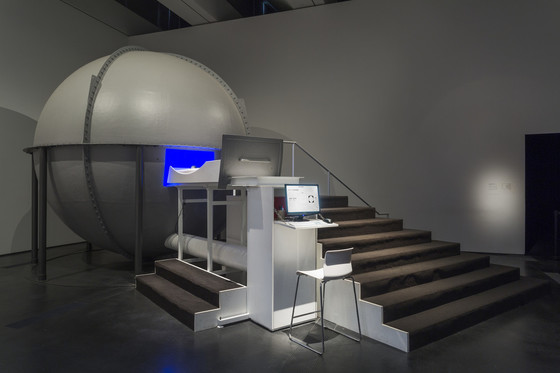James Turrell’s Light Reignfall at LACMA
Words by Katrina Mohn, Arts Writer, Bermudez Projects
There is no place where that is more apparent than in James Turrell’s Light Reignfall. The piece, which pulls directly from the artist’s investigations into sensory deprivation from the 1970s, situates the viewer isolated, prone, and encapsulated in a large orb not unlike a medical device. The viewer is alone with the art, alone with their thoughts, alone with the experience and alone with their very personal sense of perception. In fact, perceiving is all one can do.
During the late 1960s and early 1970s, James Turrell and Robert Irwin embarked on a set of perceptual experiments alongside Ed Wortz, a psychologist who worked for Garrett Corporation on “human-factor” engineering for NASA missions. The unlikely partnership was arranged by LACMA for their Art and Technology Program, wherein artists and technicians were paired to see how the marriage of art and technology might develop. Irwin, Turrell and Wortz delved into the science of perception and edges of sensory deprivation, or what is known as the Ganzfeld effect, where the subject is driven to hallucination or madness as the mind struggles to catch onto any crumb of sensory input.
Though no work was born of this partnership for the Osaka/Los Angeles exhibitions of Art and Technology, Irwin and Turrell’s experiments with soundproof, lightproof chambers remained an interest for Turrell. By presenting “viewers” (more like subjects, in this case) with a single uninterrupted field of color, how would the mind attempt to make sense of it?
Turrell’s goal here is not to drive the viewer to hallucination but instead encourage an alpha state, or the specific pattern of brain waves found in the minds of those who practice transcendental meditation. Alongside the changing strobe lights, the viewer/subject wears a set of noise-canceling headphones, which play low or high tones in rhythm with the lights. Though Light Reignfall gives 12 minutes to each viewer, other versions of the perceptual cells can be 30 minutes or more, perhaps allowing for a deeper state.
Before you enter the space, after signing a legal waiver (the likes of which people often ignore, but really shouldn’t) a white-coated art technician gives an option: hard mode or soft mode? Each is promised to be equally dazzling. Finally, you are then arranged onto a slab, fitted with the sound-cancelling headphones and a hand-held button to press in case of an emergency.
Only afterward can you compare notes with anyone, and even in the space of five or ten minute in between viewings the ephemeral nature of seeing, experiencing, and memory pulls apart what you saw – or at least what you thought you saw. Touching base with another person’s experience results in a confusing mass of half-thoughts, struggled descriptions.
There are strobes and colors and sounds. That you can agree on. In order to get a sense of physical reality sometimes you look down at your hand. If you shut your eyes the experience is merely altered, not disrupted. These are things that you can agree on. Beyond that, description falls apart. All you know is that you want to return and return until language can catch up with your eyes.
James Turrell’s Light Reignfall is ongoing until May 29, 2017. Visit www.lacma.org for ticket information.
James Turrell
Light Reignfall, 2011
Fiberglass, steel, and neon light
Gift of Hyundai Motor as part of The Hyundai Project: Art + Technology at LACMA in honor of the museum’s 50th anniversary
(c) James Turrell
photo (c) Museum Associates/LACMA


